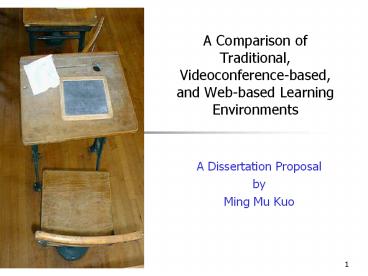A Comparison of Traditional, Videoconference-based, and Web-based Learning Environments - PowerPoint PPT Presentation
1 / 30
Title:
A Comparison of Traditional, Videoconference-based, and Web-based Learning Environments
Description:
A Comparison of Traditional, Videoconference-based, and Web-based Learning Environments A Dissertation Proposal by Ming Mu Kuo Proposal Format I. Purpose of Study II. – PowerPoint PPT presentation
Number of Views:109
Avg rating:3.0/5.0
Title: A Comparison of Traditional, Videoconference-based, and Web-based Learning Environments
1
A Comparison of Traditional, Videoconference-based
, and Web-based Learning Environments
- A Dissertation Proposal
- by
- Ming Mu Kuo
2
Proposal Format
- I. Purpose of Study
- II. Research Questions
- III. Significance of the Study
- IV. Review of Literature
- V. Research Design
3
I. Purpose of the Study
- Gain a comprehensive understanding of the
perspectives of graduate students and faculty
members in on-campus and remote sites of courses
delivered using web-based courseware and
videoconference-based (TTVN) deliveries.
4
II. Quantitative Research Questions
- What are the differences in (student
satisfaction1, peer relationships2) among
traditional, videoconference-based, and web-based
learning environments?
5
Qualitative Research Questions
- What are the differences in (faculty motivation3,
faculty load4 , faculty promotion tenure5)
among traditional, videoconference-based, and
web-based learning environments?
6
III. Significance of the Study
- The study may be valuable to higher education
institutions that are planning to provide more
instruction via the Internet or videoconference
to help determine whether those methods are
effective with their students.
7
Significance of the Study (cont..)
- Encourage more faculty members teaching at the
distance learning environments.
8
IV. Review of Literature
- Learning Environments
- Traditional
- Videoconference-based
- Web-based
9
Review of Literature (cont..)
- Student Satisfaction
- Technology
- Interaction
- Motivation to Enroll
- Experience
- as predictors
10
Review of Literature (cont..)
- Factors Related to Faculty Members
- Motivation and Incentives
- Faculty Load
- Promotion and Tenure
11
Learning Environments
- Two categories of distance education
- Separate the learner and the instructor in space
but not in time videoconference-based courses - Separated in time and space Web-based courses
12
Learning Environments (cont..)
- Traditional major advantage
- Face-to-face interaction, immediate feedback,
social contact. - Distance isolation and loneliness (Long et al.,
1999).
13
Learning Environments (cont..)
- Videoconferencing
- More channels of communication than other forms
of distance education - Technological problems, camera skills
14
Learning Environments (cont..)
- Web-base distance learning
- Internet and World Wide Web provide new
opportunities for teaching and learning - self-motivation, independent learning, time
management
15
Student Satisfaction
- Many previous studies showed
- No significant effectiveness difference among
the different distance delivery methods and
traditional learning environment
16
Student Satisfaction (cont..)
- Technology Information technologies can promote
learning that is constructivist in nature, like
any other strategy, they can result in
ineffective learning - Interaction According to Kearsley (1995), one of
the most important instructional elements of
distance education is interaction - involvement, immediately feedback
17
Student Satisfaction (cont..)
- Motivation to Enroll
- Experience
- What drive students to choose DL?
- Whats their experience in DL?
- What they expect in DL?
18
Faculty Motivation
- Positive factors as intellectual challenge,
personal motivation to use technology, ability to
reach new audiences, and opportunity to develop
new ideas - Negative Factors as lack of release time, lack of
technical support, faculty workload, and lack of
grants for materials
19
Faculty Load
- Faculty members
- Not only need to learn how to use new
technologies - Also needs to learn how to personalize their
instruction - Incorporate student involvement activities into
their instruction.
20
Faculty Load (cont..)
- According to Bradburn (2002), the overall
teaching load was somewhat higher (53) for
instructional faculty members teaching distance
classes than for those not doing so.
21
Faculty Promotion Tenure
- In most institutions the primary requirements for
promotion and tenure are publication in
traditional journals and teaching in traditional
classrooms
22
V. Research Design
- The methods of research will be MIXED-METHODS
utilizing both quantitative and qualitative in
nature and descriptive and comparative in design.
23
Population
- The subjects for this study will be students and
faculty members in courses offered over the TTVN
and Web courseware by the Texas AM University
system during the spring semester of 2005.
24
Population (cont..)
- Quantitative
- Graduate students
- Web-based course Web group
- Videoconference (in campus) Traditional group
- Videoconference (remote site) Videoconferencing
group
- Qualitative
- Faculty members
- Teaching the web-based or videoconference-based
courses
25
Instrumentation
- Quantitative
- On-line survey with 23 items that examined
technology issues, peer interaction, and overall
experience - 5 point Likert scale
- Qualitative
- Interviews will be conducted to identify faculty
motivation, load, and promotion. - 10 questions email interview
26
Research Instrument Validity
- Content validity of the on-line survey and
interview questions will be checked by a panel of
experts (N5) comprised of graduate students and
faculty members at the Texas AM University --
Kingsville.
27
Research Instrument Reliability
- Cronbachs Alpha Coefficient will be used to
check the reliability of the instrument. - A pilot study with graduate students not included
in the actual study will be conducted. (N30)
28
Data Analysis- Quantitative Survey
- A two-way contingency table analysis
- Person Chi-Square significance level 0.05
Traditional Videoconference Web-Base
Questionnaire 1
Questionnaire 23
29
Data Analysis- Qualitative Interview
- Qualitative Interview
- Coding and recoding
- Member checks
- peer debriefing
30
A Comparison of Traditional, Videoconference-based
, and Web-based Learning Environments
- A Dissertation Proposal
- by
- Ming Mu Kuo

